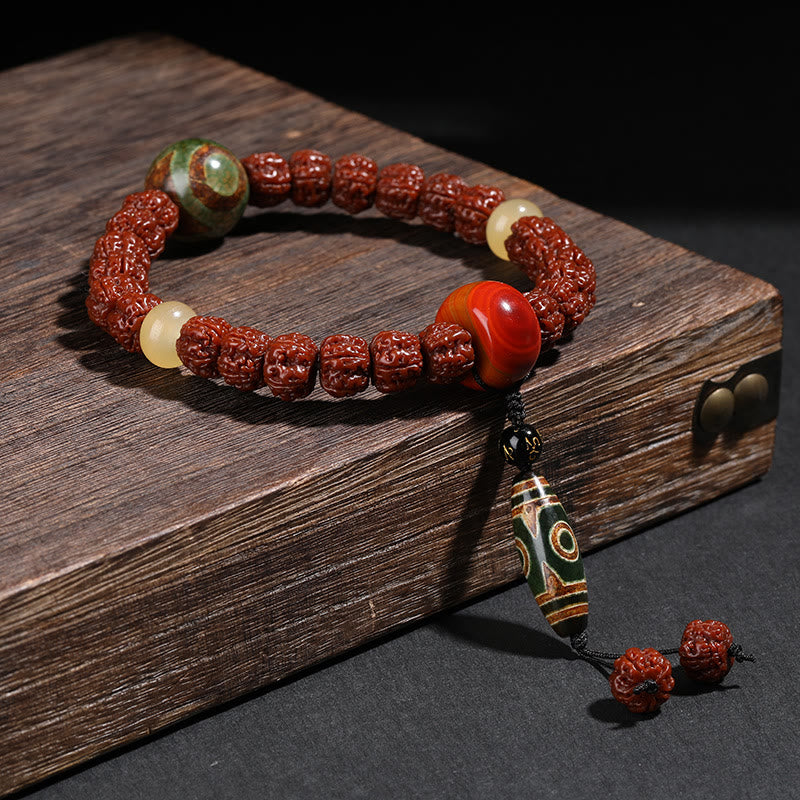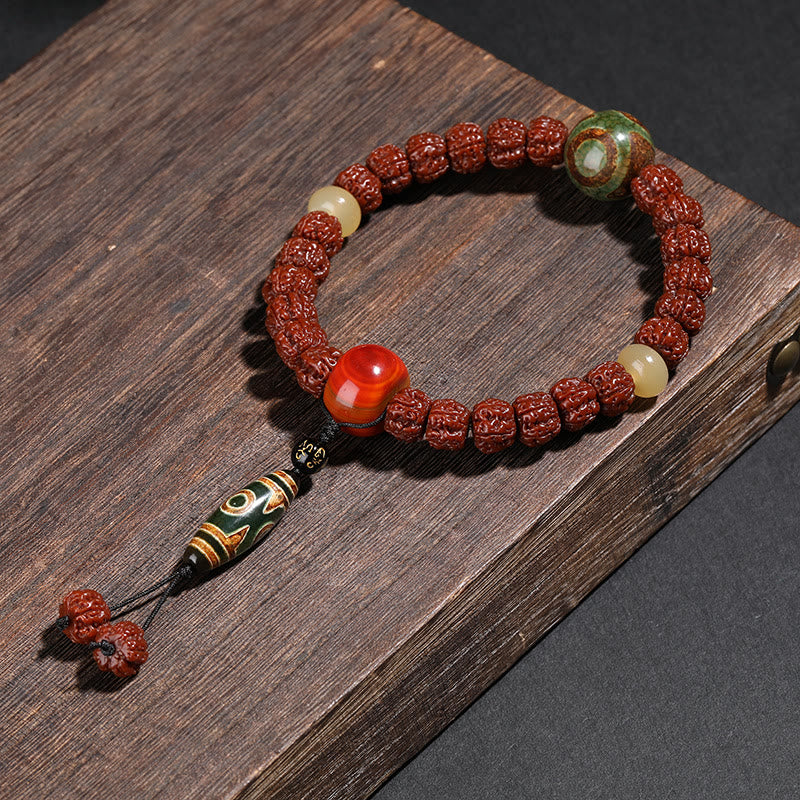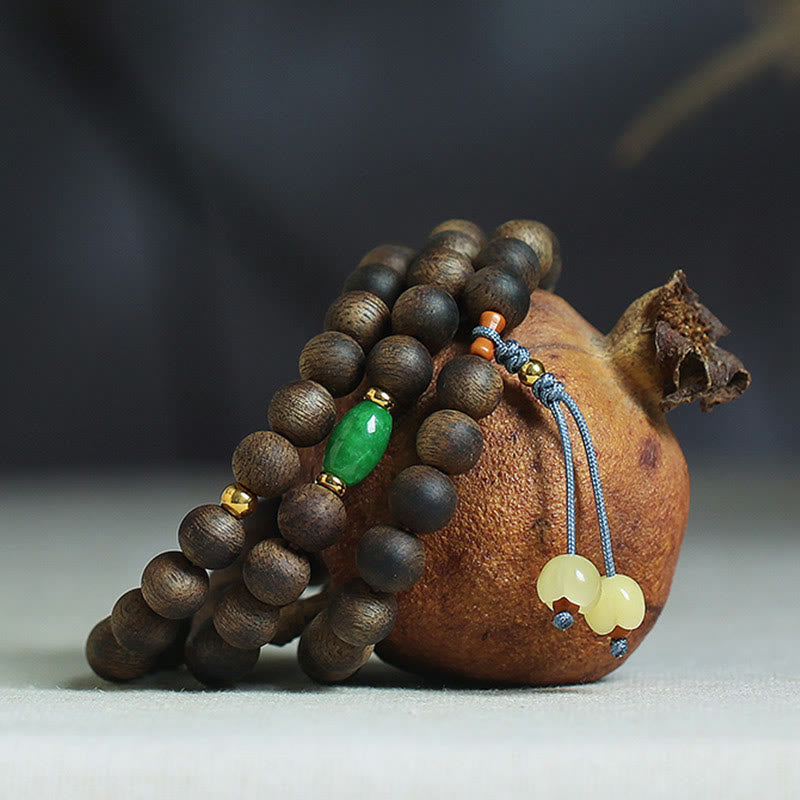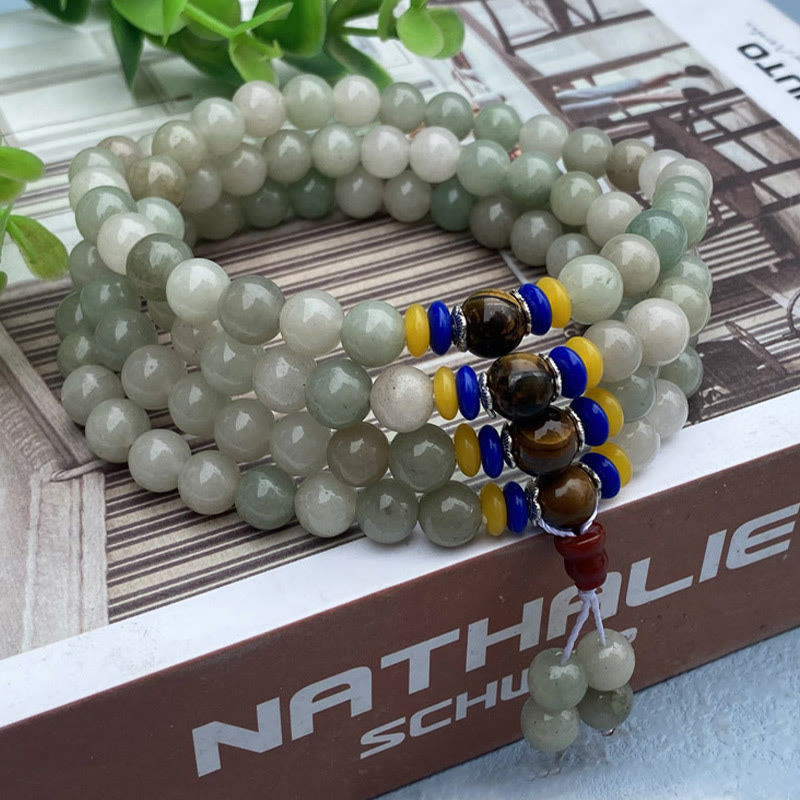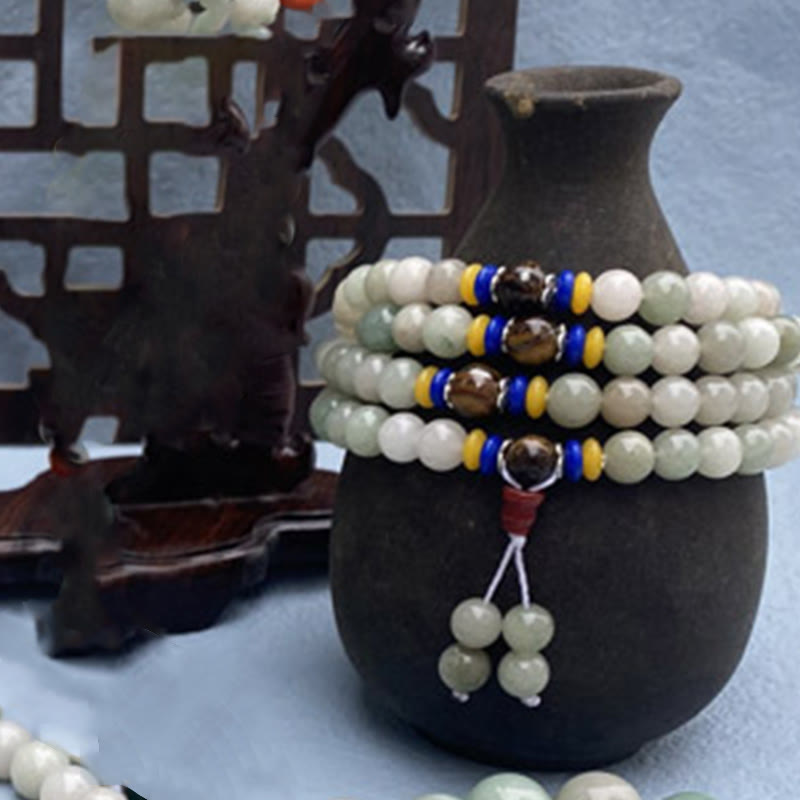Avez-vous déjà vu quelqu'un, lors d'un cours de yoga ou d'un moment spirituel, porter un magnifique collier de perles, ou le tenir silencieusement en méditation ? Plus qu'un simple accessoire spirituel, il s'agit d'un japa mala , un outil puissant et ancien conçu pour concentrer l'esprit et approfondir la connexion à un mantra choisi. Si vous vous êtes senti attiré par ces perles, mais que vous ne saviez pas ce qu'elles étaient ni comment les utiliser, vous êtes au bon endroit. Ce guide explorera la signification du japa mala et vous montrera comment l'utiliser pour améliorer votre pratique de la méditation mantra.
De la signification spirituelle de ses 108 perles à la bonne façon de le tenir, nous aborderons tout ce que vous devez savoir pour débuter cette pratique transformatrice. Un japa mala n'est pas un simple objet ; c'est un compagnon sur votre chemin vers la paix intérieure, la pleine conscience et la découverte de soi. Explorons comment cet outil sacré peut ancrer votre concentration et élever votre méditation.
Qu'est-ce qu'un Japa Mala ?
Un japa mala est un collier de perles utilisé dans les pratiques spirituelles et de pleine conscience pour compter les mantras, les prières, les intentions ou les respirations. Le mot sanskrit « japa » signifie « murmure » ou « répétition », tandis que « mala » signifie « guirlande ». Un japa mala est une « guirlande de répétition », un outil tangible qui aide à maintenir l'esprit libre pendant la méditation. Utilisés depuis des siècles dans des traditions comme l'hindouisme, le bouddhisme et le sikhisme, les malas sont devenus un outil précieux pour les personnes en quête spirituelle du monde entier qui cherchent à cultiver la concentration et un état de conscience plus profond.
La pratique des perles de méditation mantras permet de créer un rythme apaisant le bavardage constant de l'esprit. En passant vos doigts d'une perle à l'autre pendant la récitation du mantra, vous stimulez votre sens du toucher, ce qui ancre votre conscience dans l'instant présent. Ce geste physique procure un rythme méditatif régulier, facilitant l'accès au calme et à la concentration.

L'anatomie sacrée d'un mala
Un japa mala traditionnel est plus qu’un simple collier de perles ; chaque composant a un but et un symbolisme spécifiques qui contribuent à son pouvoir en tant qu’outil méditatif.
Pourquoi 108 perles ? La signification spirituelle
La question la plus fréquente à propos des malas est de savoir pourquoi ils comptent traditionnellement 108 perles . Le nombre 108 est considéré comme sacré dans de nombreuses religions et traditions orientales pour diverses raisons. Bien qu'aucune raison ne soit définitive, sa signification spirituelle est profonde. Voici quelques interprétations courantes :
- Connexion cosmique : La distance moyenne du Soleil et de la Lune à la Terre est de 108 fois leurs diamètres respectifs.
- Chakra du cœur : On pense qu'il existe 108 lignes d'énergie, ou nadis, convergeant pour former le chakra du cœur.
- Alphabet sanskrit : L'alphabet sanskrit compte 54 lettres. Chacune possède une qualité masculine (Shiva) et féminine (Shakti), soit un total de 108.
- Achèvement spirituel : Certains croient que si vous pouvez rester dans un état d’immobilité pendant 108 respirations, vous atteindrez l’illumination.
En fin de compte, les 108 perles servent de guide, vous aidant à effectuer un nombre défini de répétitions sans avoir à vous concentrer sur le comptage, vous permettant de vous immerger pleinement dans le mantra.
Le gourou des perles et des pompons
Chaque japa mala possède à sa base une perle supplémentaire, souvent plus grande, appelée perle du Guru ou perle « meru » (montagne). Cette 109e perle n'est pas comptabilisée parmi les 108 répétitions. Elle sert de point de départ et d'arrivée à votre méditation, symbolisant la relation Guru-élève ou votre connexion à une puissance supérieure. Lorsque vous atteignez la perle du Guru, c'est le moment de marquer une pause, de réfléchir et d'exprimer votre gratitude avant de terminer votre pratique ou de reprendre la même direction pour entamer un nouveau cycle.
Le pompon, qui s'étend de la perle Guru, représente le lien avec le divin et l'unité de toutes choses. Les nombreux brins du pompon s'unissent pour former une seule unité, symbolisant notre interdépendance.
Les matériaux comptent : choisir vos perles Japa Mala
Les japa malas sont fabriqués à partir de divers matériaux, chacun étant censé posséder une énergie et des propriétés uniques. Le choix du matériau est personnel et peut s'harmoniser avec votre intention de pratique.
Les matériaux courants comprennent :
- Graines de Rudraksha : Considérées comme sacrées dans l'hindouisme, ces graines sont associées au Seigneur Shiva et sont censées offrir une protection et apaiser l'esprit.
- Bois de santal : Connu pour son arôme apaisant, le bois de santal est censé favoriser la tranquillité et un état d'esprit positif.
- Pierres précieuses : Des cristaux comme l’améthyste (clarté), le quartz rose (amour) et le jade (prospérité) sont utilisés pour insuffler à la pratique des qualités énergétiques spécifiques.
- Graines de Bodhi : Ces graines proviennent de l'arbre Bodhi, sous lequel le Bouddha a atteint l'illumination, ce qui en fait le symbole de l'éveil spirituel.

[curseur de collection]
Comment utiliser votre Japa Mala pour la méditation mantra
Utiliser un japa mala est une pratique simple mais profonde. Suivre ces étapes vous aidera à établir une routine de méditation mantra significative.
- Trouvez un espace calme et fixez-vous une intention : Asseyez-vous confortablement dans un endroit calme où vous ne serez pas dérangé. Prenez quelques respirations profondes pour vous recentrer. Fixez-vous une intention pour votre pratique : que souhaitez-vous cultiver ? Paix, clarté, compassion ?
- Choisissez votre mantra : Un mantra est un mot, un son ou une phrase répété pour favoriser la concentration. Il peut être en sanskrit, comme « Om » ou « So Hum », ou une simple affirmation en français, comme « Je suis calme ». Choisissez-en un qui vous parle.
- Tenez le mala correctement : tenez votre mala dans votre main droite , car cette main est traditionnellement associée à la transmission et à la réception d'énergie positive. Placez les perles sur votre majeur. L'index est associé à l'ego et n'est généralement pas utilisé pour toucher les perles. Utilisez votre pouce pour tirer chaque perle vers vous.
- Commencez le chant : Commencez par la première perle à côté de la perle du gourou. En touchant la perle avec votre pouce, récitez votre mantra (en silence ou à voix haute). Après une récitation complète, utilisez votre pouce pour tirer la perle suivante vers vous et répétez.
- Atteindre la perle du gourou : Continuez ce processus jusqu'à avoir récité votre mantra 108 fois et atteint la perle du gourou. Lorsque vous le sentez, prenez un moment pour vous arrêter et honorer votre pratique. Ne dépassez pas la perle du gourou. Pour continuer un tour, retournez simplement le mala et reprenez la direction opposée.

Pour un aperçu visuel de cette magnifique pratique, regardez la vidéo ci-dessous. Elle montre clairement comment tenir le mala et parcourir les perles avec votre mantra.
Bracelet unisexe Rudraksha Bodhi Seed Dzi Bead Bodhi Seed Mala
$25.90 $37.90
Faites l'expérience d'une méditation mantra authentique avec ce mala Rudraksha & Bodhi Seed, fabriqué à la main pour une pratique spirituelle profonde.
Explorer le produitÉtiquette du Japa Mala : règles et bonnes pratiques
Un japa mala est considéré comme un outil sacré , et le traiter avec respect peut approfondir son importance dans votre pratique. Bien qu'il n'existe pas de « règles » strictes, des principes traditionnels honorent sa fonction spirituelle.
- Conservez-le sacré : Rangez votre mala dans un endroit spécial lorsqu'il n'est pas utilisé, comme un petit sac ou sur un autel. Évitez de le poser par terre.
- Purification de votre mala : Les malas peuvent absorber l'énergie ; il est donc conseillé de les purifier régulièrement. Vous pouvez le faire en les plaçant au clair de lune, en les purifiant avec de la sauge ou près d'un bol chantant.
- Usage personnel : Votre mala est un objet personnel qui s'harmonise avec votre énergie. Il est généralement recommandé de ne pas le laisser manipuler trop fréquemment.
- Porter votre mala : Vous pouvez parfaitement porter votre mala en collier ou autour du poignet. Ainsi, il vous rappellera vos intentions tout au long de la journée.
Comme indiqué dans un article du Yoga Journal , plus vous utilisez votre mala, plus il absorbe votre énergie, devenant un puissant objet d’intention et de concentration.
Découvrez votre compagnon de méditation idéal
Améliorez vos rituels de méditation mantra avec ce mala complet de 108 perles, mélangeant du bois d'agar, du jade cyan et de l'ambre pour l'harmonie. En savoir plus ➔
$24.90
$35.90
Découvrez la tradition avec ce mala en jade Shetai, idéal pour le comptage des mantras, les énergies de prospérité et les routines quotidiennes de pleine conscience. En savoir plus ➔
Conclusion : Votre chemin vers la pratique consciente
Un japa mala est bien plus qu'un magnifique bijou spirituel ; c'est un pont vers une pratique de méditation plus profonde et plus ciblée. Il agit comme un guide, vous aidant à suivre vos mantras et à ancrer votre esprit dans l'instant présent. En comprenant sa structure, la signification sacrée de ses 108 perles et sa méthode d'utilisation simple, vous pouvez accéder à une nouvelle dimension puissante de votre cheminement spirituel.
Que vous choisissiez un mala de graines de Rudraksha pour la protection ou de Jade Shetai pour la prospérité, l'essentiel est l'intention que vous mettez dans votre pratique. Nous vous invitons à explorer notre collection de malas authentiques, fabriqués à la main, et à trouver celui qui parle à votre âme, prêt à vous accompagner sur le chemin de la paix intérieure.
Questions fréquemment posées sur les Japa Malas
Un japa mala est principalement utilisé comme outil de comptage pendant la méditation. Il permet de compter le nombre de fois qu'un mantra, une prière ou une affirmation est récité, permettant ainsi à l'esprit de se concentrer sur la répétition plutôt que sur le comptage. Ce processus rythmique contribue à apaiser l'esprit et à approfondir l'état méditatif.
Oui, il est tout à fait acceptable de porter un japa mala. Nombreux sont ceux qui le portent en collier ou autour du poignet pour se souvenir de leurs intentions et pratiques spirituelles tout au long de la journée. Cependant, il doit être considéré comme un objet sacré plutôt que comme un simple accessoire de mode. Il est préférable de le retirer lors d'activités intenses ou pour prendre un bain afin de préserver son intégrité.
Bien qu'il n'existe pas de « règles » strictes, les principes traditionnels recommandent de traiter son mala avec respect. Les pratiques clés incluent : tenir le mala de la main droite , utiliser le pouce pour tirer les perles sur le majeur, ne pas laisser le mala toucher le sol et ne pas croiser la perle du gourou lors d'une série de 108 chants. Il est également recommandé de le conserver dans un lieu propre et sacré.
Le nombre 108 est considéré comme sacré dans de nombreuses traditions spirituelles. Sa signification est diversement interprétée, notamment en raison des 108 lignes d'énergie (nadis) qui convergent pour former le chakra du cœur, des 108 lettres de l'alphabet sanskrit (54 masculines et 54 féminines) et des liens cosmologiques liés au Soleil, à la Lune et à la Terre. Ce nombre représente la plénitude spirituelle.
Pour chanter avec un japa mala, tenez-le dans votre main droite, en le passant sur votre majeur. En commençant par la perle à côté de la perle du gourou, tirez doucement la première perle vers vous avec votre pouce tout en récitant votre mantra une fois. Passez à la perle suivante pour la récitation suivante, et ainsi de suite, jusqu'à ce que vous ayez terminé les 108 perles et atteigniez à nouveau la perle du gourou.


